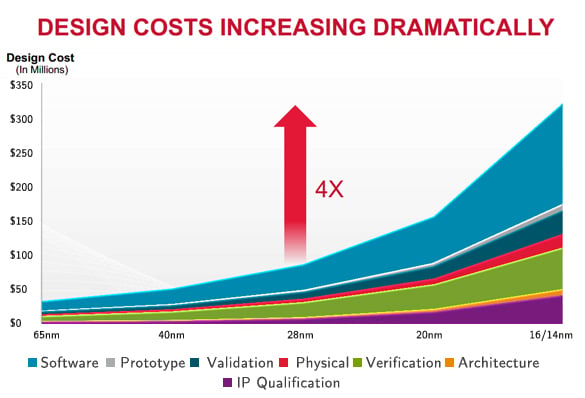Search engine giant Google (GOOG 0.35%) may be considering designing its own server processors using technology from ARM Holdings (ARMH +0.00%), according to a rumor spread by Bloomberg on December 12.
Although this move would clearly benefit ARM Holdings, which sells its intellectual property to third parties, it would do so by hurting Intel (INTC 0.79%), which gets over 4% of its total revenue from the search giant and controls 95% of the market for server chips that use PC processors. Google is Intel's fifth largest customer, and spends hundreds of millions in server processors every year. But why would Google, clearly a software-oriented company, be interested in manufacturing its own server processors? More importantly, can Google design a chip with similar performance than what Intel's own processors can provide?
Google has what it takes to design its own chip
As tech expert Stephen Shankland notes, it's possible for Google to design its own server processors. First of all, Google already builds its own servers and related software. Second, the company also has chip design expertise in house, like scientist Luis Andre Barroso, who did pioneering work on multicore chips technology when he worked at Digital Equipment Corporation. According to Shankland, Barroso has written a novel computing approach that would be well-suited to ARM processors.
A quick review of Google's past acquisitions confirms the search engine giant is very interested in processors. The company bought a start-up named PeakStream in 2007, which specialized in creating programming tools for multi-core processor software development. It also bought ARM-based chip designer Agnilux in 2010. Founded by members of legendary Palo Alto Semiconductor, Agnilux was rumored to make super efficient processors for servers.
Finally, with monopoly like profits, Google has enough cash to acquire a ready-made team of chip engineers, if needed. The industry is used to see tech giants acquire engineering teams for specific tasks. For example, Apple acquired Palo Alto Semiconductor to obtain fablesschip design know-how, and Broadcom acquired NetLogic to gain processors used in data networks. In this sense, the ultimate confirmation that Google is more than interested in designing its own server processors, would be an acquisition of a chip firm.
Benefits
Google may have plenty of incentives to make its own server chips. First, by using ARM technology -- which focuses in low power consumption, and may be useful for low-stress server tasks such as reading logs or doing simple database queries -- Google could save big money in electricity bills. According to software expert James Pearn, Google had around 2.3 million servers in early 2013, over eight operational data centers. The amount of electricity needed to keep such an amount of servers operational is huge.
Second, according to Bloomberg's source, by using its own designs, "Google could better manage the interactions between hardware and software." Liz Markman, a spokeswoman for Google, declined to say whether the company may develop its own chips, but did mention Google is actively engaged in designing the world's best infrastructure, both at the hardware and software level.
Intel, don't panic
Short term, there is no need for Intel to panic here. Even if Google were to design its own server chips, due to the complexity of the task, it would take the company many years before it can achieve full-scale industrial manufacturing of server chips with better power characteristics than what Intel offers. Second, according to Broadcom, chip design costs have increased dramatically in the past years, and therefore Google may need to do some serious investments to have its own chips. This is unlikely to happen in the short run.

Source: Broadcom's Analyst Day Presentation slides
Finally, since Google has a huge and complex computing infrastructure, there may be a place for Intel even after Google successfully designs and manufactures and ARM-powered server chip. This is because, as Shankland mentions, ARM chips could fit in for some workloads, but higher-performance chips would still be needed in abundance.
Final Foolish takeaway
Bottom line, Google can develop its own server chips in the long run, because it already has plenty of chip engineers in its team. It also has the cash needed to buy a specialized chip firm, or invest in prototype building.
More important, it may have the incentive to build its own chip, because this could save the search engine giant millions of dollars in electricity bills. However, the reality is that chip design and manufacturing is a long term, complex process. Intel does not need to panic here. Finally, due to Google's huge computing infrastructure, there may always be a place for Intel's high-performance chips in Google's datacenters.





